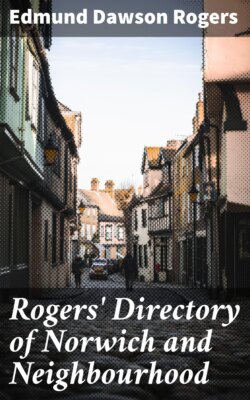Читать книгу Rogers' Directory of Norwich and Neighbourhood - Edmund Dawson Rogers - Страница 8
На сайте Литреса книга снята с продажи.
CHAPELS.
ОглавлениеTable of Contents
The Old Meeting House, Colegate street, was erected in 1693 by the Independents, a congregation of which body had existed in Norwich since the Commonwealth. They had originally assembled in a brewery in St. Edmund’s, and afterwards in the “west granary” of St. Andrew’s Hall. The Old Meeting is built of red brick, fronted with four Corinthian pilasters. The Rev. John Hallett is the minister.
Prince’s Street Chapel, another Independent place of worship, was erected of white brick, with boldly-displayed cornice and pediment, and a Doric portico of four columns. The cost was upwards of £4500. The Rev. John Alexander has been the minister ever since its erection.
A third Congregational Chapel, a very handsome building erected in the vicinity of Chapel Field, was opened in 1858. Rev. Philip Colborne, minister.
The Tabernacle, St. Martin’s at Palace—originally built by the Calvinistic Methodists—was, in 1775, purchased by the Countess of Huntingdon. Rev. J. J. J. Kempster, minister.
St. Mary’s (Baptist) was rebuilt in 1811 and enlarged in 1839. Its chief feature is a beautiful vaulted roof. The Rev. Joseph Kinghorn was for many years the pastor. Rev. George Gould, minister.
St. Clement’s, another Particular Baptist place of worship, was built in 1814, at a cost of £5000. Rev. T. A. Wheeler, minister.
Orford Hill Chapel, also Baptist, was opened as a chapel in 1832. Rev. T. Corbet, minister.
Ebenezer Chapel, Surrey Road, was built in 1854; a gallery was subsequently added. The congregation had previously assembled in the Bazaar, St. Andrew’s; the minister being the Rev. R. Govett, who, some years since, seceded from the Established Church.
There are several smaller structures in connexion with this denomination.
The General Baptists, established in the city since 1686, have a chapel in St. James’, erected in 1812 on part of the site of the White Friary. Rev. Thomas Scott, minister.
The Octagon (Unitarian) Chapel, St. George’s, is a handsome building, of the shape implied by its name. It is surmounted by a dome, supported by eight Corinthian pillars. It was erected in 1756, on the site of the old Presbyterian Meeting-house. Dr. John Taylor, and Dr. Enfield (compiler of the Speaker) preached in this chapel. Rev. J. H. Hutton, minister.
The Society of Friends have two meeting-houses in Norwich; one of which, in Upper Goat Lane, is a fine white-brick structure, with Doric portico, and lighted by a dome lantern. It was rebuilt in 1826. The other is the Gildencroft Meeting House, St. Augustine’s, erected in 1680. There is a spacious burial-ground attached, in which are deposited the remains of Joseph John Gurney, Mrs. Opie, and other eminent Friends. This building is supported by two lofty oak pillars, cut out of single trees.
The Roman Catholics have also two chapels. That in St. John’s Maddermarket is an ancient but plain structure, rebuilt in 1794; that in Willow Lane, called the Chapel of the Apostles, is a handsome building, erected in 1828. The windows are of stained glass, and the interior decorations are very striking.
The Dutch Church, in St. Andrew’s Hall, originally the Conventual Church of the Black Friars, was granted to the Walloon congregation; but they now have service only once a year, when a sermon is preached in Dutch and afterwards in English. The building is used as a chapel to the Workhouse, but it is expected that it will be occupied by the Free Christian Church when the New Workhouse, now being erected near the Cemetery, has been completed.
Calvert Street Chapel, built by the Wesleyans in 1811. Since the recent disruption in that body, it has been held by the Reformers, or United Methodist Free Church; as is also the case with New City Chapel, in Crook’s Place.
St. Peter’s Chapel (Lady’s Lane), held by the Conference Wesleyans, was built in 1824.
The Primitive Methodists have chapels in Heigham (St. Benedict’s Road), Lakenham (St. Catherine’s Plain), Cowgate Street, and New Catton.
The French Church, Queen Street—originally the parochial church of St. Mary Parva, and afterwards a cloth exchange—was granted, in 1637, to the French Protestant refugees. It is now leased to the receivers of the doctrines enunciated by Emanuel Swedenborg, and the minister is the Rev. David Goyder.
The Free Christian Church, St. Michael at Plea, which is unconnected with any particular denomination, was opened in 1852, upon its pastor, the Rev. Joseph Crompton, quitting the Unitarians, of which denomination he had been minister.
The Jews—who were formerly very numerous in this city—have a handsome synagogue in St. Faith’s Lane. Rev. S. Caro, minister.
